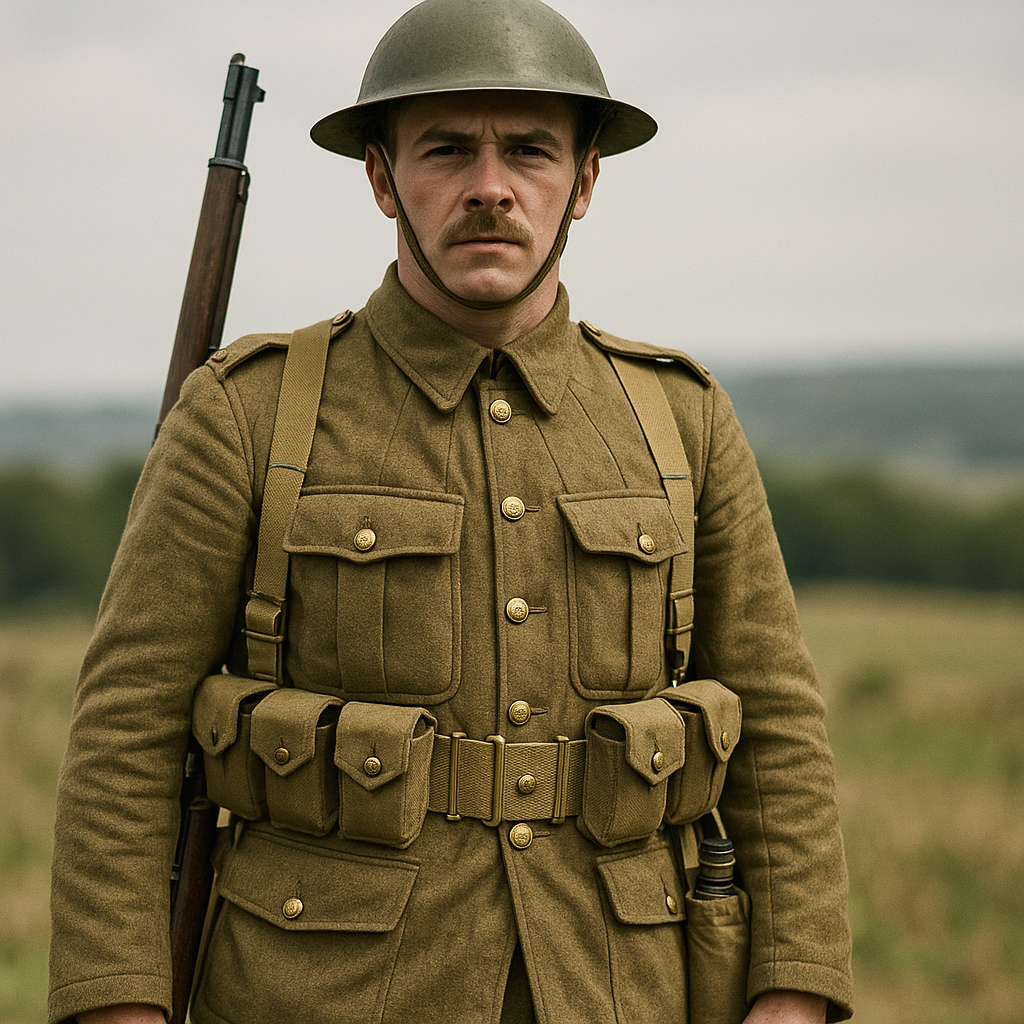
"British Uniform WW1: A Deep Dive into the Iconic Attire of the Great War"
Published on Jun 25, 2025
British Uniform WW1: A Deep Dive into the Iconic Attire of the Great War
World War I (1914–1918) marked a turning point in global history, reshaping nations, technologies, and even wars. One of the most visually striking aspects of the Great War was the uniform British soldiers wore. The British WW1 uniform wasn't just a piece of clothing—it was a carefully engineered outfit meant to withstand the rigors of trench warfare, signal authority, and represent national pride.
This comprehensive guide explores the elements, history, and legacy of the British uniform in WWI and why it continues to interest collectors, historians, and enthusiasts alike.
The Beginning of Modern Military Dress
Prior to WWI, the British Army still used bright red coats and formal attire. But with the outbreak of war and the need for effective camouflage, the Service Dress—introduced in 1902—became the standard. By the time WWI began, British soldiers were equipped with uniforms that prioritized functionality over flair.
Key Components of the British WW1 Uniform
Here’s a breakdown of the standard items worn by a British soldier during World War I:
1. Service Dress Tunic
Made of heavy wool, the tunic was dyed khaki to blend with the landscape. It featured:
- Four large pleated pockets
- A stand-and-fall collar
- Epaulettes for rank insignia
- Brass buttons with regimental insignia
Wool kept soldiers warm but could become incredibly uncomfortable when wet, a frequent problem in the muddy trenches of the Western Front.
2. Trousers
British WWI trousers, also made of wool, were baggy and ended just below the knee. Soldiers wore puttees—long woolen strips wrapped from ankle to knee—for extra protection and support.
3. Headgear
Initially, soldiers wore the peaked service cap. Still, as trench warfare intensified, the Brodie helmet (or "Tommy helmet") was introduced in 1915. This steel helmet offered better protection from shrapnel and bullets.
4. Boots
British soldiers wore hobnailed leather boots designed for durability. However, poor drainage in the trenches often led to trench foot, making footwear a critical yet problematic part of the uniform.
5. Equipment and Webbing
Soldiers carried a lot:
- Lee-Enfield rifle
- Ammunition pouches
- Water bottle
- Mess tin
- Bayonet
- Gas masks (especially from 1915 onward)
These items were supported by the 1908 Pattern Web Equipment, a system of canvas straps and pouches designed for easy access and weight distribution.
Variations by Rank and Regiment
While the general issue uniform was standard, there were differences based on:
- Rank – Officers had better-quality tunics, often privately purchased.
- Regiment – Highland regiments might wear kilts, while some colonial troops had variations in fabric or design.
Khaki: More Than a Color
The shift from bright red to khaki was more than just aesthetic. It represented a change in warfare tactics:
- Camouflage – Essential for trench warfare and sniper evasion.
- Morale – Uniformity boosted a sense of unity and pride.
- Practicality – Khaki wool was less visible in mud and dirt.
The Role of the Uniform in Trench Warfare
The conditions in the trenches were brutal—wet, cold, and infested with vermin. The British WW1 uniform had to:
- Provide warmth
- Allow freedom of movement
- Carry essential gear
- Offer some degree of protection
Yet, the uniform had its limitations. Wool absorbed water quickly, and the weight of wet gear could be overwhelming. Despite this, the British soldier’s outfit remained unchanged throughout the war, a testament to its basic utility.
Specialized Uniform Adaptations
As the war evolved, so did uniform needs:
- Gas attacks prompted the introduction of PH helmets and the Small Box Respirator.
- Winter clothing was issued in colder months—thick gloves, scarves, and goat-skin jerkins.
- Tropical versions of the uniform were used in campaigns like Gallipoli and Mesopotamia.
Legacy and Collectibility
Today, the British uniform from WWI is highly sought after by collectors and reenactors. Authentic pieces can fetch high prices, and reproduction uniforms—such as those available on Paddelaters—allow enthusiasts to experience history.
The uniform also occupies a place in public consciousness, frequently depicted in films, documentaries, and museums. It symbolizes sacrifice, endurance, and national identity.
Why the British WW1 Uniform Still Matters Today
Understanding the British WW1 uniform gives us more than just a look into past fashion—it opens a window into:
- The challenges soldiers face daily
- The evolution of modern warfare
- National values and identity during times of conflict
For collectors, historians, educators, or military enthusiasts, owning or studying a piece of this history offers a tangible connection to one of the 20th-century's pivotal events.
Where to Find Authentic British WW1 Uniforms
At Paddelaters, we specialize in accurate replicas and authentic military uniforms. Whether you're building a collection, participating in reenactments, or creating educational displays, our pieces reflect the detail and quality of the original British WW1 service dress.
We offer:
- Reproduction tunics and trousers
- Webbing and equipment
- Headgear, including Brodie's helmets
- Accessories and insignia
Explore our full range at paddelaters.com.
Conclusion
The British uniform of World War I is more than wool and brass—it’s a symbol of the resilience, discipline, and history of an army that endured one of humanity's most devastating conflicts. From the muddy trenches of Flanders to the parades back home, this uniform stood as a silent witness to the bravery and sacrifice of millions.
By understanding its components, uses, and evolution, we gain a richer appreciation of the Great War and the soldiers who fought it. If you want to own a piece of that legacy, start your journey at Paddelaters—where history is stitched into every seam.
